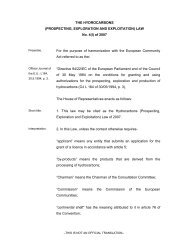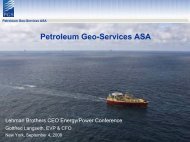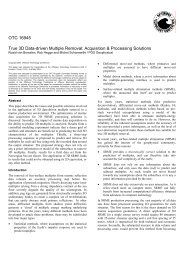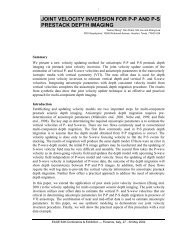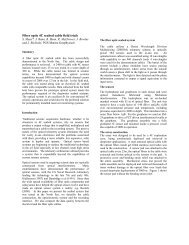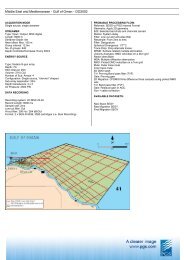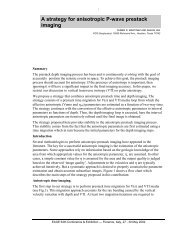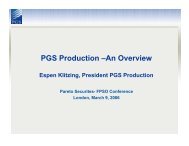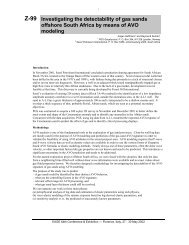Annual Report 2011 - PGS
Annual Report 2011 - PGS
Annual Report 2011 - PGS
Create successful ePaper yourself
Turn your PDF publications into a flip-book with our unique Google optimized e-Paper software.
Operations<br />
Operations<br />
HSEQ performance delivers cost effective operations<br />
State-of-the-art fleet<br />
<strong>PGS</strong> has shown<br />
an improving HSEQ<br />
performance over the last<br />
years and Operations aims<br />
at improving the results<br />
even further<br />
Building Competitive<br />
Advantages<br />
<strong>PGS</strong>’ Operations business unit supports<br />
Marine Contract and MultiClient with reliable<br />
and efficient production capacity. Efficient<br />
operation of sophisticated systems enhances<br />
customer satisfaction and <strong>PGS</strong>’ profitability.<br />
Health, Safety, Environment and Quality (HSEQ)<br />
performance is important for safe and efficient<br />
operations of seismic vessels. Operations<br />
aims at improving <strong>PGS</strong>’ HSEQ results, in<br />
particular the lost time injury incidents, where<br />
the Company experienced an increase in<br />
<strong>2011</strong>. <strong>PGS</strong>’ HSEQ management systems set<br />
the framework for high quality product and<br />
service by continuous risk assessment of all<br />
operations, job tasks, processes and systems.<br />
These systems have undergone a thorough<br />
review by DNV this year in conjunction with<br />
the OHSAS 18001 certification process. During<br />
this process the systems and implementation<br />
of the systems offshore and in the office were<br />
reviewed.<br />
Training and continuous development of<br />
employees are important to maintain skilled<br />
and motivated staff. Automation of work<br />
processes by new vessel and equipment design<br />
contributes to improved efficiency and reduced<br />
risk for personnel injuries. The overall Lost Time<br />
Incident Frequency (LTIF) for vessel operations<br />
increased to 1.29 per million man-hours in<br />
<strong>2011</strong> compared to 0.89 in 2010, while <strong>PGS</strong><br />
experienced a decrease in the Total Recordable<br />
Case Frequency (TRCF) to 2.06 per million manhours<br />
compared to 2.80 in 2010. <strong>PGS</strong> also has a<br />
high environmental focus and strong awareness<br />
of Corporate Social Responsibility at all levels.<br />
The Ramform Advantage<br />
<strong>PGS</strong> is recognized throughout the industry<br />
for its unique Ramform vessels. The seismic<br />
vessels have a delta-shaped hull that is<br />
distinguished by an extremely wide aft beam,<br />
twice the width of a conventional vessel.<br />
The broad aft workspace allows for efficient<br />
deployment and retrieval of streamers and<br />
seismic sources. The Ramform’s propulsion<br />
power is also industry leading. The<br />
Ramform S-class has enough thrust to tow a<br />
1.4-kilometer wide spread of streamers more<br />
than eight kilometers long. The acknowledged<br />
efficiency and productivity benefits of <strong>PGS</strong><br />
Ramform vessels, along with the effectiveness<br />
of <strong>PGS</strong>’ personnel, make the <strong>PGS</strong> fleet industry<br />
leading.<br />
In <strong>2011</strong>, <strong>PGS</strong>’ Marine streamer fleet consisted of:<br />
JJ<br />
Seven Ramform vessels, capable of towing<br />
up to 22 streamers each<br />
JJ<br />
One vessel in the medium-capacity segment,<br />
capable of towing 10 streamers<br />
JJ<br />
Three classic streamer vessels, capable of<br />
towing up to eight streamers<br />
JJ<br />
Two 2D/source vessels.<br />
The Nordic Explorer, one of the three classic<br />
streamer vessels, was converted from 3D to 2D<br />
in December <strong>2011</strong>. The Nordic Explorer replaced<br />
the Harrier Explorer as a 2D/source vessel;<br />
the latter was returned to its owner when the<br />
vessel’s charter expired in September <strong>2011</strong>.<br />
Continuous Focus on Reducing Technical<br />
Downtime — Best-in-Class Performance<br />
Technical downtime as a percentage of total<br />
fleet time has dropped sharply from roughly<br />
14 percent in 1992 to about 3.5 percent in<br />
<strong>2011</strong>. Similarly, performance increased from<br />
approximately 80 percent in 1997 to 91 percent<br />
28 <strong>PGS</strong> <strong>Annual</strong> <strong>Report</strong> <strong>2011</strong>



